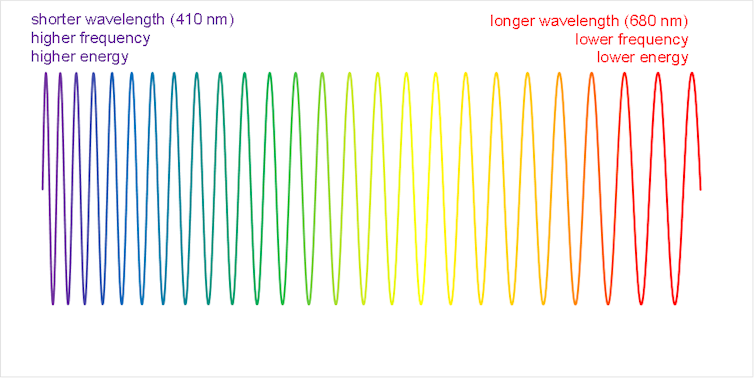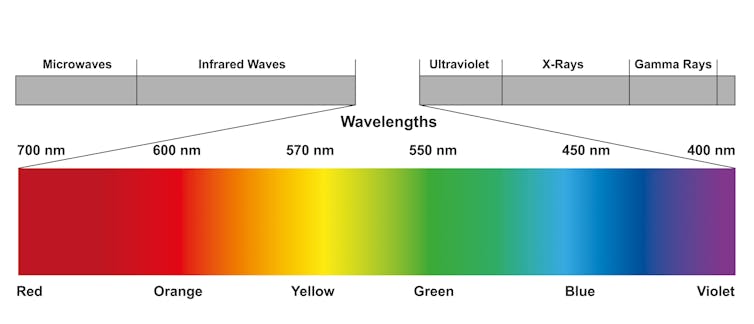The place does black fall on the colour spectrum? – Utsav, age 17, Navi Mumbai, Maharashtra, India
Individuals love the rainbow of ROYGBIV colours: pink, orange, yellow, inexperienced, blue, indigo and violet. Human eyes understand seen mild as this array of colours.
You could discover that some colours you may understand aren’t a part of the traditional rainbow, although. The place is black, for instance?
I’m an affiliate professor of shade science, a subject that mixes physics and notion. Colour scientists are keen on studying extra about human imaginative and prescient and making use of that information to make shade techniques – equivalent to in cameras, screens or lighting techniques – work higher.
To grasp the place black falls on the colour spectrum, first think about what mild truly is.
Mild is radiation seen to the human eye
Mild is power referred to as electromagnetic radiation. It’s made up of a stream of power particles referred to as photons.
Every photon has its personal power stage. There are two traits you need to use to explain a photon. Its frequency is how briskly it vibrates backwards and forwards – or oscillates – because it travels. And its wavelength is the gap between these oscillations in area.

Mild is made up of photons touring as waves via area.
DrSciComm by way of Wikimedia Commons, CC BY
As photons with wavelengths inside a spread of about 400–700 nanometers stream into your eyes, your mind perceives them as mild. Scientists name these photons seen radiation. You understand photons with totally different wavelengths as totally different colours.
Photons outdoors that vary of wavelengths are invisible to human eyes. Shorter wavelength power contains ultraviolet, X-ray and gamma radiation, whereas longer wavelength power contains infrared and radio waves.

The human eye can understand solely a small vary of wavelengths of radiation.
Ali Damouh/Science Picture Library by way of Getty Photographs
Shades and intensities
Colour notion can be affected by the amount of photons – what physicists name the facility – at totally different seen wavelengths. Extra photons means extra highly effective mild, which seems to be brighter. A really vivid shade consists largely of photons of comparable wavelength. For instance, a pure pink might include photons that every one share the identical wavelength close to 620 nanometers.
A stream of photons with a wider vary of wavelengths will seem as a paler, much less saturated shade. White mild, equivalent to pure daylight, consists of photons with wavelengths unfold pretty evenly throughout a variety of the seen spectrum. LEDs and different electrical mild sources aren’t fairly as uniform throughout the spectrum, however they nonetheless seem white or achromatic, that means with out shade.
Mixtures of wavelengths mix and seem as new colours. The human visible system interprets pure pink mild and pure inexperienced mild mixed as yellow. Add in pure blue, and this mixture of radiation seems white. Scientists and engineers make the most of this high quality in show gadgets, that are capable of create an enormous vary of perceived colours by mixing the first colours pink, inexperienced and blue.
Black on the colour spectrum
Whereas there’s no black in a rainbow, photons wherever within the electromagnetic spectrum will be seen as black. Or in some instances, they’ll’t be seen in any respect!
Radiation throughout the seen spectrum can seem black whether it is low in energy – extra particularly, decrease in energy than its environment.
Moreover, radiation outdoors the seen vary of wavelengths seems black to our eyes. For instance, infrared radiation seems black as a result of it’s invisible to people.
Notion is subjective
Our eyes detect the wavelength and energy of the sunshine, however our brains interpret it. So shade notion at all times depends upon the context.
Persons are good at adapting to a variety of sunshine ranges, from daylight to starlight. So our notion of shade and brightness depends upon what’s round and what we’ve been taking a look at lately. Should you step from out of doors daylight right into a darkish theater, at first you in all probability understand the entire setting as black, and you could even have hassle discovering your method.
Nevertheless, your visible system instantly begins to adapt to the low mild stage. Quickly, visible particulars start to emerge. What appeared black now has totally different ranges of lightness and shade.

Colour notion depends upon the encircling setting.
Michael J. Murdoch
Think about the optical phantasm that consists of a light-weight rectangle subsequent to a darkish rectangle. Every rectangle comprises a circle. The circles look like totally different shades however in truth are an identical. Towards the sunshine background, the circle is darkish sufficient to seem black. Surrounded by the black background, it turns into clear that the circle is merely darkish grey. Even when you understand the circles are the identical, it’s laborious to imagine as a result of the impact of the encircling background is so sturdy.

In a clean gradient from grey to black, the place does black start?
Michael J. Murdoch
You may be asking your self, how darkish should a shade be to seem black? One other technique to ask the query is, how low in energy should the bodily mild be with a view to look black?
For a visible reply, have a look at a gradient from darkish grey to black. The place within the gradient is the boundary, or threshold, at which you name it black? What should you dim your show or view the display screen in a a lot brighter or a lot darker setting? In all probability the most effective reply for a way darkish it should be is, “It depends.”
Colour notion is a captivating subject, and we shade scientists are persevering with to uncover particulars of how the human visible system works whereas additionally making use of our information to many different helpful issues, together with dyes, cameras, printers, LED lighting techniques and AR/VR shows.
And since curiosity has no age restrict − adults, tell us what you’re questioning, too. We received’t have the ability to reply each query, however we’ll do our greatest.